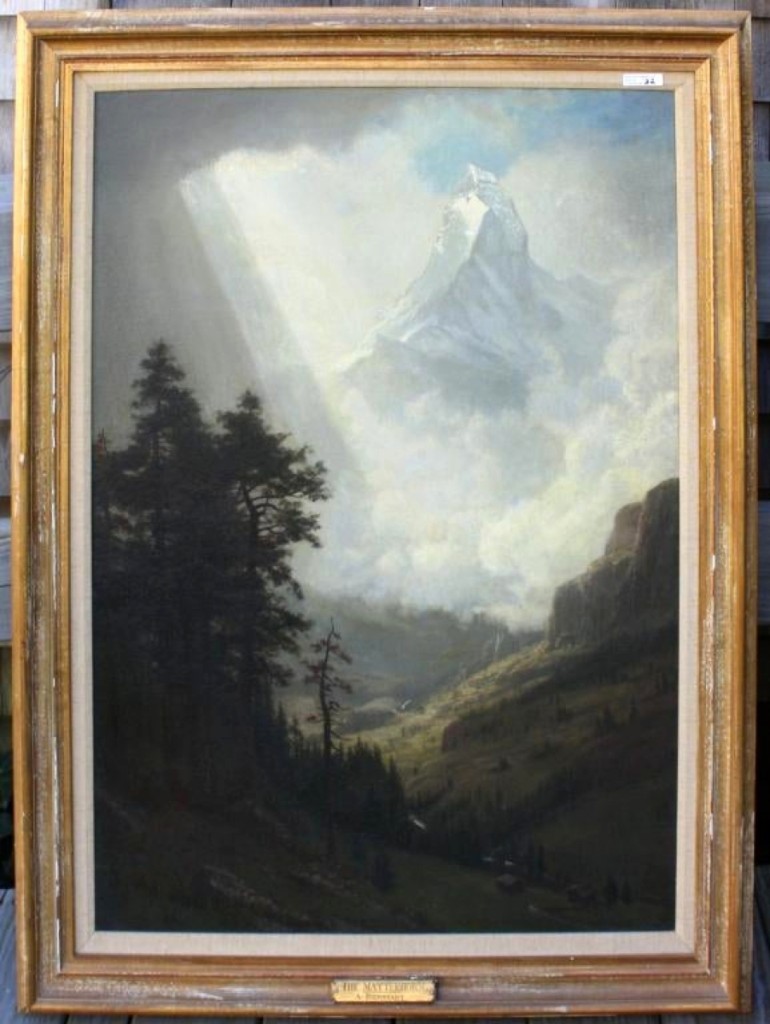
The highest priced item of the day was Albert Bierstadt’s oil on canvas of “The Matterhorn.” The circa 1855 painting brought $40,950.
Review and Onsite Photos by Rick Russack, Additional Photos Courtesy of Marion Antique Auctions
MARION, MASS. – Frank McNamee of the Marion Antique Shop and Dave Glynn, Turkey Creek Auctions, Citra, Fla., teamed up for another Thanksgiving weekend sale on November 30. They do two or three sales a year under the name of Marion Antique Auctions, and all the merchandise is fresh to the market. That probably accounts for the active bidding – live, online, phone and absentee.
Glynn handles the podium duties, and he’s been doing it for a while; he started when he was 15. McNamee and Glynn have been friends and have been involved with the antiques business since they were teenagers. Since all the merchandise is fresh, much from local estates, the offerings are varied: fine art, firearms, Midcentury Modern, scrimshaw and other whaling material, silver, ceramics and more. This sale included a collection of Twentieth Century Italian glass, Mexican and American coins, early Scottish and other European firearms. Some of the scrimshaw had been consigned by the New Bedford Whaling Museum, and there were numerous sets of silver flatware, tall case clocks and more. But best of all was a life-sized Steiff horse.
You probably haven’t seen a stuffed horse this large. The photo shows that he’s taller than Frank McNamee. It was mostly black, 6 feet tall and was in great condition, with only minor wear around the hooves. The horse had been in the window of the F.A.O. Schwarz store in New York, and in 1989 it was donated to a charity auction for the benefit of children at Bellevue Hospital. It was purchased by the consignor’s mother and when the children lost interest, it was put into storage. Until now. Admittedly, it would be hard to get it home, but it would be a great conversation piece. A phone bidder took advantage of the lack of interest in the room and bought it for just $585, well below the estimate. We don’t expect to see another one any time soon.
The highest priced item of the day was “The Matterhorn” by Albert Bierstadt, (1830-1902). It depicted the massive mountain in the Swiss Alps in a landscape surrounded by forest and clouds. The painting brought far over the estimate, finishing at $40,950, selling to a collector from Syracuse, N.Y., who had come down a couple of days prior to the sale to examine it in person. Bringing less money but popular in the Marion area and Cape Cod was a painting by Martha Cahoon (1905-1999), wife of Ralph Cahoon. Her work is similar to that of her husband, and her oil painting of a festive winter scene with a horse-drawn sleigh, farm buildings and skaters on a pond earned $2,808.
The sale started off with scrimshaw and related marine items. An oddity, a carved wooden folk art figure of Abe Lincoln, 11 inches tall, with scrimshawed head and hands, seemed like a good buy, selling to an internet bidder for $819. A buyer in the room was successful on several of the scrimshawed whale’s teeth. He bought the first lot of the day, a pair of mid-Nineteenth Century teeth, one of which showed the Boston Sloop of War on one side, and the second tooth depicted the Rhode Island Hotel on one side. Both were about 6 inches long and decorated on both sides; this pair brought $3,276. The same buyer in the room paid $1,755 for a tooth just under 7 inches long that showed a busy port scene with four ships on one side and a European city scene on the other side. Several lots of Twentieth Century scrimshaw were deaccessioned by the New Bedford Whaling Museum and were being sold to benefit the museum’s acquisition fund. Two teeth by scrimshaw artist Roberta Dutra, who died in 2001, sold for $819. She was an art teacher for 36 years in the New Bedford school system. Appropriately, sold with the scrimshaw portion of the sale was a circa 1840 portrait of a sea captain holding a telescope, with a sailing ship in the background. He was identified as Captain Alfred Pratt.

One of the higher priced items in the sale was this watercolor by Lionel Feinnger. It was signed and titled “Farewell” and finished at $15,795.
There was not a lot of early furniture in the sale, but a complex Dutch tall case clock made by Daniel Perrin, with a domed bonnet and fretwork and a burl walnut and mahogany veneered case reached $4,563. The dial had three rocking ships, a village scene, a calendar movement with moon phase and a date, time and second dial. An Eighteenth Century heavily restored spice cabinet with replaced feet, drawers and molding was in need of still more work. But it had good old butterfly hinges and an older reddish surface. It sold for $644, and the right person could get it looking good.
It’s safe to assume that one of the consignors was of Scottish descent. The group of firearms included several early Scottish examples. A pair of late Eighteenth Century steel flintlock pistols, marked “P. McNab” on the lock plates, along with other dates, numbers and letters, sold for $3,627. A circa 1710 .60 caliber flintlock pistol in original condition with ramrod brought $2,106. A circa 1760-70 English brass barreled flintlock blunderbuss, signed “Webb and Riggs” and with sliver and wire inlay realized $2,223. Probably from the same Scottish collector came four lots of Scottish silver-mounted horn snuff boxes, some with agate stones in the covers. A lot of two, one dated 1842 and the other dated 1925, earned $410. Others, sold in groups, averaged $40/60 each. It was an interesting, uncommon collection.
There were some good buys, two especially noteworthy towards the end of the day and particularly for book dealers. And one other lot proved that things sold at auction tend to average out. Most came from the estate of Calvin Bullock, a wealthy stockbroker and owner of 1 Wall Street. Of particular interest was a complete boxed set of 88 issues of Charles Dickens’ Master Humphrey’s Clock, a monthly magazine Dickens published of short stories, miscellaneous observations and commentary. Lasting only from 1840 to 1841, it spun off some major works, including The Old Curiosity Shop. The “narrator” of the tales is Master Humphrey, who describes his daily life and his encounters with vivid characters, including Mr Pickwick. The clock in the title is his old companion, where he stored his manuscripts. Sets of this publication are listed online between $1,600 and $7,500; this one sold for $1,112. Also in this part of the sale was a leather-bound first edition of The House at Pooh Corner by A.A. Milne. It was cataloged as having only “minor loss to the spine” and sold for $234. Our review of the Boston book fair [See Antiques and The Arts Weekly, December 13, 2019] noted that a set of the four Pooh books, trade editions with paper dustjackets, was offered for more than $11,000, and Skinner’s book sale included a similar set that sold for just under $5,000. The Bullock library also included three copies of The Little Prince by Antoine de Saint-Exupéry. One was a signed first edition in a clipped dust jacket that had some minor wear. It sold far over the estimate, finishing at $7,020. Dave Glynn later said he thought that the color of this particular dust jacket was the reason it did so well.
A few days after the sale, Glynn said he believed that overall results were solid. “We did about $410,000, which is about where we expected to be. The scrimshaw prices seemed a little soft, but other things made up for that. The guy that bought the Bierstadt is really happy. And the Steiff horse is going to a good home where he’ll have real horses for company. The firearms were fine. Twentieth Century furniture did well, but there wasn’t much interest in the abstract paintings. All in all, Frank and I are pleased.”
Prices given include the buyer’s premium as stated by the auction house.
For information, 671-748-3606 or www.marionantiqueauctions.com.























